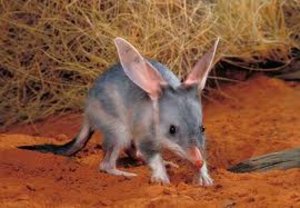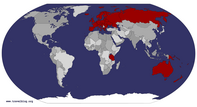Advertisement
Published: October 1st 2011

 I am a Bilby - please help me to survive
I am a Bilby - please help me to survive
you can do that by becoming a 'Friend of the Bilby' (www.savethebilbyfund.org)Thursday 29th September - our hopes for some calm weather were dashed - there was lightening, thunder and very heavy rain for very long periods throughout the night. Anyone under canvass would have had a tough time but we were quite cosy in the caravan apart from the noise of the rain beating down on the caravan roof. We were both a bit restless but, as we had nothing planned for the day-time, we were able to have a “lie-in”. Graham is usually up with the lark but even he was still in bed at 9:30am!!! He usually tells me how many caravans have moved on and what time the earliest one left. This morning, all the movers had gone before he got up!! The weather was very much better – just a bit of a breeze blowing. Yesterday we had received a visit from the park cat. There are several notices around the park asking people to check their caravans before they depart as the orange cat – Puddy – has been known to stow away in departing vans and had travelled around much of Queensland. We had discouraged her from entering yesterday but this morning she was here again.

 Weary Willy
Weary Willy
'His name is 'Weary' and his face, is one you'd see in every place. He's been through cold and rain and heat, with aching limbs and tired feet. From head to toe he seems to sag, he's travelled far, and humped his swag. His dog, too tired to scratch a flea now leans against his masters knee. If you felt travel-stained and sad, feel better now you're not this bad. Although you've lost a little zest, poor 'Weary' here can never rest' by R & P DavisWe were just going in to town when she arrived so, again, we didn’t let her in but on our return about an hour later, Puddy showed up and waltzed straight into the caravan and settled on the padded seat. She was quite relaxed and showed no signs of leaving so we let her stay. She promptly went to sleep and spent about three hours with us. At about 5 o’clock we began to get ready for our “bilby” night so we invited her to leave and she did just that!! No doubt we’ll see her again tomorrow.
We arrived early at the Charleville Bilby Experience. It was due to start at 6:00pm with a talk, then a DVD about the founders of the “Save The Bilby” organisation and then a viewing of some bilbies. They are small nocturnal marsupials so the viewing could only be done after 7:00pm when it was dark. They are the only surviving member of their branch of the bandicoot family in Australia and have wonderful large ears, a silky grey coat and a peculiar black tail with a white fluffy bit on the end. Their pouch is unusual as it opens backwards. Because
we were early we were invited to stroll around the gardens where a large enclosure housed some yellow-footed rock wallabies that are part of a breeding programme. They were fascinating and seemed to be equally fascinated by us. They are very pretty with yellow hoops on their tails. By the time we had returned to the conference room, many more people had arrived and more were to follow. The entrance fee was only $5 so it’s not surprising that it’s a very popular show. It’s designed purely to raise funds to establish and maintain an area of bush where bilbies can survive and thrive in an effort to stop them disappearing altogether in the wild. Numbers have dwindled over the years because of the increase in their predators - feral cats (millions) and foxes (hundreds of thousands) - and the bilby is now very endangered. This organisation was founded by two men, Peter McRae, a zoologist, and Frank Manthey, a wildlife enthusiast, who raised so much awareness that a television programme was made about them and that was the DVD we watched. They managed to secure various avenues of funding to acquire a 25 square kilometer area of Queensland bush
and to erect an electrified predator-proof fence around it. The next task was to eradicate all the predators from within the area and that was completed in 2003. Some bilbies already existed in the area and the organisation is devoted to producing more and more in captivity here in Charleville before releasing them into the wild bush area. A complex breeding programme is being carried out which at least gives the bilby a chance of survival but the more support they get the more they will be able to achieve. We were invited to visit the bilby shop, where I duly spent lots of money, and then to proceed to the viewing area where a few of the breeding marsupials were on display. They were all under infra-red lights but could clearly be seen and they were extremely active, dashing about animatedly. We were allowed to take photos as long as we didn’t use a flash setting but that was more or less a waste of time as the wire fencing and the lighting resulted in photos of red blobs! It was a brilliant experience which, because of their charming appearance, really tugged at the heart-strings. It’s just the sort

 The 'rain making' guns
The 'rain making' guns
In 1902 during the longest running drought in Queensland history, Clifford Wragge, a renowned meteoroligist, brought 6 of these guns to Charleville and fired 'rain producing gas' into the atmosphere - the experiment failed but it did rain later in the year!of organisation that, if I lived here, I would readily volunteer my services for.
After the show we went looking for a “chippie” but, apart from a few pubs, Charlevile seemed to be closed! So we went back to the caravan where I rustled up a pasta supper. The night was very calm and without any traffic noise it was easy to get another good night’s sleep.
Unlike yesterday, we didn’t lie in this morning, Friday, but we had nothing planned for the daytime. Many vans had left so until early afternoon the park was very quiet with only about eight units remaining. But soon after 2:00pm some new travellers began to arrive including a noisy family next to us. But we’re on the road tomorrow so we won’t have to put up with them for more than one night. And, as it happens, we’re out tonight visiting The Cosmos Show – doing a bit of star-gazing and we’ll be getting back very late. So today we did very little, although I changed the sheets and got them washed and dried in no time at all. When I took them off the line they were warm as though
they’d been in a drier! Puddy the orange cat duly arrived at about 9:30 and she’s been with us all day though mainly outside, swapping between a chair, in the sun, and a box with some padding on under the table, in the shade.
The afternoon and early evening were idled away reading, dozing, chatting to neighbours and talking to the cat! Eventually Puddy toddled off and we began to think about our evening out. It was to be a late start – 9:00pm – so I had plenty of time to prepare tea and also to make some sandwiches for our journey tomorrow. We already know where we’re going – Roma – as we’ve already booked ahead. While chatting, a neighbour advised Graham that Roma is another mining place that has a lot of FIFO (fly in/fly out) workers and caravan parks often get full quickly. But we managed to secure a site at a Top Tourist park so we know we’ll have a spot. Roma is about 300 kilometers away so we’ll need a fairly prompt start in the morning if we’re going to have time to see a bit of the place. Graham has already put

 'Pud' makes herself at home!
'Pud' makes herself at home!
but we have mixed feelings about cats as they are responsible for the deaths of so many mammals and birds (probably not Pud though!)a lot of stuff away.
Our star-gazing night was hugely successful. Once we’d negotiated the access to the car park with just side-lights on (they don’t like headlights as it can detract from the viewing quality in the observatory) we entered the main building and sat a while watching a video until all of the patrons had arrived. We were then led (it was pitch black) into the huge, domed observatory and invited to sit while the leading scientist, Greg Field, explained the procedure. He gave us all some insight into the magnitude of what we were about to witness and it was mind-boggling. He explained the vast distances involved, particularly the concept of a light year (the usual distance measurement) which is the distance light travels in one year at 186000 miles per second!!! Our Galaxy, the Milky Way, is one hundred thousand light years across!!! It contains between 250 billion and 400 billion stars!!! After the introductions the huge domed roof of the observatory was drawn back to reveal a fantastically “full” night sky – the sort of sky we don’t seem to get in the northern hemisphere. Charleville was specially selected as the site for the
Cosmos Centre because of the absence of interfering artificial light which can affect quality viewing of the stars. Also, we were very lucky because a couple of circumstances came together giving us a wonderful view – there were no clouds at all and the moon was crescent shaped and not filling the sky with light. We were invited in turn to look through one of three magnificent telescopes which had been automatically programmed to focus on a series of stars selected just to demonstrate what can be observed. For example we saw Antares – the brightest star in the constellation Scorpius – 700 times larger than our sun and 10000 times brighter. We saw Tucana 47 – the second largest globular cluster in the night sky – 16000 light years away from our sun – made up of 100,000 stars!!! Albireo is a double star which looks to be a single one to the naked eye. Through the telescope we could see that it is actually two stars – one small blue star and a large orange/red star – 385 light years away from us and separated by 12 billion kilometres!!! Every viewing was awe inspiring and finished on a
high with a beautifully clear viewing of the planet Jupiter – the fifth planet from the sun with a diameter of 143000 kilometers (Earth is 12,756 kilometers) – it has 65 moons and we could clearly see a few of them. It was a truly magical event and we were so pleased we had made the effort to attend.
Our return to the caravan park was very late – perhaps the latest in all of our travels around Aus - so we quietly crept into the caravan and went to bed quite quickly. Our stay in Charleville had been fascinating and despite our late finish, we would be hitting the road early in the morning to make our way towards Roma – the best part of three hundred kilometres away.
Advertisement
Tot: 0.097s; Tpl: 0.014s; cc: 13; qc: 23; dbt: 0.0675s; 1; m:domysql w:travelblog (10.17.0.13); sld: 1;
; mem: 1.1mb




















